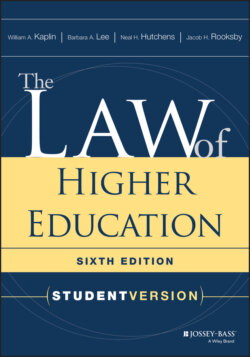The Law of Higher Education

Реклама. ООО «ЛитРес», ИНН: 7719571260.
Оглавление
William A. Kaplin. The Law of Higher Education
Table of Contents
List of Illustrations
Guide
Pages
The Law of Higher Education
Student Version
Notice to Instructors
Notice of Website and Periodic Supplements for the Student Version
Crosswalk for the Student Version and The Law of Higher Education, Sixth Edition
Preface
How the Student Version Was Developed
Developments in Higher Education Law Since the Publication of the Fifth Edition
Organization and Content of the Student Version
A Note on Nomenclature
Recommendations for Using the Student Version and Keeping Up-to-Date
Endnote
Acknowledgments
The Authors
General Introduction: The Study of Higher Education Law
A. The Universe of Education Law
B. The Governance of Higher Education
C. Sources of Higher Education Law
D. The Legal Relationships Within Institutions of Higher Education
E. The Law/Policy Distinction
F. The U.S. Legal System As It Relates to Higher Education Law
Notes
1 Overview of Higher Education Law
Section 1.1. How Far the Law Reaches and How Loudly It Speaks
Section 1.2. Evolution of Higher Education Law
Section 1.3. The Governance of Higher Education
Section 1.4. Sources of Higher Education Law
1.4.2 External sources of law
1.4.3 Internal sources of law
Section 1.5. The Public-Private Dichotomy
1.5.2. The state action doctrine
Section 1.6. Religion and the Public-Private Dichotomy
Section 1.7. The Relationship Between Law and Policy
Notes
2 Legal Planning and Dispute Resolution
Section 2.1. Legal Liability
Section 2.2. Litigation in the Courts
Section 2.3. Alternative Dispute Resolution
Section 2.4. Institutional Management of Liability Risk6
Notes
3 The College's Authority and Liability
Section 3.1. The Question of Authority
Section 3.2. Institutional Tort Liability
3.2.2 Negligence
Section 3.3. Institutional Contract Liability
Section 3.4. Institutional Liability for Violating Federal Constitutional Rights (Section 1983 Liability)
Notes
4 The College and Its Employees
Section 4.1. Overview of Employment Relationships
Section 4.2. Employment Contracts
Section 4.3. Collective Bargaining
Section 4.4. Personal Liability of Employees
4.4.2 Tort liability
4.4.4. Constitutional liability (personal liability under Section 1983)
Section 4.5. Employment Discrimination
Section 4.5.2. Sources of law
Section 4.6. Affirmative Action1
Section 4.7. Application of Nondiscrimination Laws to Religious Institutions
Note
5 Special Issues in Faculty Employment
Section 5.1. Overview
Section 5.2. Faculty Contracts
Section 5.3. Faculty Collective Bargaining
Section 5.4. Application of Nondiscrimination Laws to Faculty Employment Decisions
Section 5.5. Affirmative Action in Faculty Employment Decisions
Section 5.6. Standards and Criteria for Faculty Personnel Decisions
Section 5.7. Procedures for Faculty Employment Decisions
5.7.2. The public faculty member's right to constitutional due process
Notes
6 Faculty Academic Freedom and Freedom of Expression
Section 6.1. General Concepts and Principles
Section 6.2. Academic Freedom in Teaching
Section 6.3. Academic Freedom in Research and Publication
Section 6.4. Academic Freedom in Religious Colleges and Universities
Notes
7 The Student-Institution Relationship
Section 7.1. The Legal Status of Students
Section 7.2. Admissions
7.2.4. The principle of nondiscrimination
Section 7.3. Financial Aid
7.3.5. Discrimination against noncitizens
Section 7.4. Student Housing
7.4.3. Searches and seizures
Section 7.5. Campus Computer Networks
Section 7.6. Campus Security
Section 7.7. Other Support Services
Section 7.8. Student Records
Notes
8 Student Academic Issues
Section 8.1. Overview
Section 8.2. Grading and Academic Standards
Section 8.3. Online Programs
Section 8.4. Academic Accommodations for Students with Disabilities
8.4.2. Requests for programmatic or other accommodations
Section 8.5. Sexual Harassment of Students by Faculty Members
Section 8.6. Academic Dismissals and Other Academic Sanctions
8.6.5. Procedures for academic sanctions
Notes
9 Student Disciplinary Issues
Section 9.1. Disciplinary and Grievance Systems
Section 9.2. Disciplinary Rules and Regulations
Section 9.3. Procedures for Suspension, Dismissal, and Other Sanctions
9.3.2. Public institutions: Disciplinary sanctions
Section 9.4. Student Protests and Freedom of Speech
Section 9.5. Speech Codes and the Problem of Hate Speech3
Notes
10 Rights and Responsibilities of Student Organizations and Their Members
Section 10.1. Student Organizations
Section 10.2. Fraternities and Sororities
Section 10.3. The Student Press
Section 10.4. Athletic Teams and Clubs
Notes
11 The College and Government
Section 11.1. Local Government Regulation
Section 11.2. State Government Regulation
11.2.4. Other state regulatory laws affecting postsecondary education programs
Section 11.3. Federal Government Regulation
11.3.2. Federal regulation of postsecondary education
Section 11.4. Federal Aid-to-Education Programs
Section 11.5. Civil Rights Compliance3
11.5.3. Title IX.5
Notes
12 The College and External Private Entities
Section 12.1. The Education Associations
Section 12.2 Business Partners
Notes
Appendix A: Constitution of the United States of America: Provisions of Particular Interest to Postsecondary Education
Appendix B: The American Court System
Notes
Appendix C: Reading and Analyzing Court Opinions
Appendix D: Glossary of Legal Terms
Bibliography
Chapter 1
Chapter 2
Chapter 3
Chapter 4
Chapter 5
Chapter 6
Chapter 7
Chapter 8
Chapter 9
Chapter 10
Chapter 11
Chapter 12
Statute Index
Case Index
Subject Index
WILEY END USER LICENSE AGREEMENT
Отрывок из книги
William A. Kaplin
.....
The Court also rejected two other arguments of the teachers: that the school was engaged in state action because it performed a “public function” and that the school had a “symbiotic relationship” with—that is, was engaged in a “joint venture” with—government, which constitutes state action under the Court's earlier case of Burton v. Wilmington Parking Authority, 365 U.S. 715 (1961) (discussed above). As to the first argument, the Court reasoned in Rendell-Baker that the appropriate inquiry was whether the function performed has been “traditionally the exclusive prerogative of the state” (quoting Jackson v. Metropolitan Edison Co., 419 U.S. at 353). The Court explained that the state never had exclusive jurisdiction over the education of students with special needs and had only recently assumed the responsibility to educate them.
As to the teachers' second argument, the Court concluded simply that “the school's fiscal relationship with the state is not different from that of many contractors performing services for the government. No symbiotic relationship such as existed in Burton exists here.”
.....